Classes in Hearthstone have identities. Sometimes these identities are clear, sometimes they are quite garbled, but just name almost any class in Hearthstone and, if you have played the game for a while, you know the types of things they are capable of. There are hardly any control Rogues or Hunters around, those classes are more tempo-based, sometimes even pure face decks and Rogue can also do some tricks and be a combo deck. Priest, on the other hand, is usually a slow grind, even more so after the rework where it loses all of its combo capabilities.
What about the new Demon Hunter? We have already taken a look at Demon Hunter basics, like their one-mana Hero Power to gain +1 Attack for a turn, how to unlock the class, and what cards they will have. But what will it be like to actually play as a Demon Hunter? What kinds of decks can you expect to use with the new class?
In Your Face!
In the reveal stream, Celestalon discussed Blizzard’s goals with Demon Hunter: “We wanted to deliver on Demon Hunters being in your face, constantly attacking. Not just the Hero Power, there is a variety of ways that Demon Hunters get to attack.”
Iksar chimed in: “They’re attacking all the time, they’re taking advantage of their attacks all the time … Demon Hunter is in your face all the time.”
They also discussed the various archetypes and strategies they want to support for Demon Hunter:
- Demon Hunters can use swarm strategies, but they do not buff their minions. Instead, they can benefit from minions dying.
- Demon Hunters have card draw, so they can potentially build combo decks.
- Demon Hunters can use big Demon minions as a late-game strategy.
What would these strategies look like in practice and how viable are they?
Aggro Demon Hunter
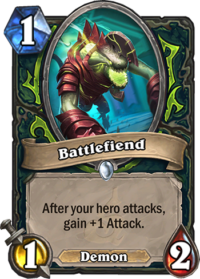
Demon Hunter is an aggressive class, and playing an aggro deck is well within their capabilities. The Demon Hunter initiate set includes perhaps the most powerful aggro-deck one-drop in the game, Battlefiend. It needs to be answered quickly or it keeps growing and dealing a lot of damage. With a good curve, a Demon Hunter can follow it up with Umberwing on turn two and Satyr Overseer on turn three. Against a slow control deck that does not do too much in the early game, think current Highlander Mage, that would be a board of two 4/2s, a 2/2, and two 1/1s on turn three! Twin Slice and Eye Beam make it possible to remove threats with no additional mana, so the same board state can be achieved even against a more proactive opponent.
Aggro Demon Hunters do not need to worry too much about their health total, so they can happily use their face to trade away the opponent’s early-game minions while their own minions keep hitting face, and then move on to hitting face in the mid-game when they can no longer hold the board. I expect the playstyle to resemble the current Dragon Hunter decks, except that whereas Dragon Hunter uses spells and Battlecry effects to maintain board control early on, Demon Hunters will use their Hero.
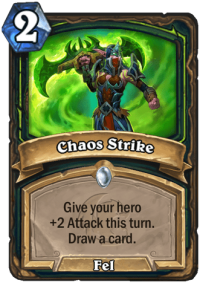
Demon Hunters have access to a lot of cheap card draw that also provides them with utility. In particular, I expect Chaos Strike to be a part of every Demon Hunter deck regardless of the archetype, because it supports their overall plan to use their Hero to attack and it’s a cantrip that draws a replacement card upon use. The pre-nerf Power Word: Shield is one of the closest cards it can be compared to. Consume Magic and Spectral Sight also fit in aggressive decks, because they are cheap ways to get more resources. With the Silence effect from Consume Magic, Taunt minions cannot save slow decks from Demon Hunter’s assault.
Metamorphosis gives Demon Hunter a good deal of reach in the mid-game, ideal for finishing the game after the board is lost. No Leeroy Jenkins anymore? No problem for Demon Hunter!
This type of pure aggro deck, a Demon Face Hunter, if you will, looks almost certain to succeed, especially on the lower ranks of the ladder, where new players get access to it for free. In Hearthstone, tempo is the key to victory, and aggressive Demon Hunters have plenty of tools to gain and maintain tempo.
Token Demon Hunter
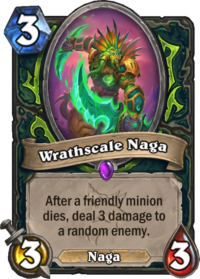
In the reveal stream, Celestalon and Iksar discussed the possibility of Demon Hunter token strategies. If it works, it will be a very different strategy from any token strategy we have seen before in Hearthstone because they specifically mentioned that Demon Hunters do not buff their minions, but instead benefit from their minions dying.
There has never been a viable token strategy in Hearthstone that does not include some way to give the minions additional attack: Savage Roar, Murloc Warleader, Bloodlust, Unseal the Vault – every successful token strategy has had some way to add attack.
Demon Hunters have tools like Wrathscale Naga that deals damage when tokens die and Feast of Souls that allows Demon Hunters to draw a bunch of cards when tokens die, but nothing that makes the tokens themselves more powerful.
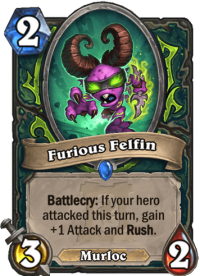
They can summon several Rush tokens with Coordinated Strike and Command the Illidari, but something is still missing to make this strategy a viable one. We have not seen all the cards yet, so more cards like Wrathscale Naga could help, but it is currently difficult to see tokens as the main win condition for Demon Hunter.
Maybe Murlocs? There is actually a Demon Hunter Murloc, Furious Felfin. Murlocs also have a tribal attack buff in Murloc Warleader, thereby overcoming the lack of class-specific attack buffs. The only Neutral Murloc that rotates out of Standard now is Murloc Tastyfin, and Demon Hunters have a bunch of cheap card draw anyway. I’m a little scared this might actually be viable.
Control Demon Hunter
Seriously?
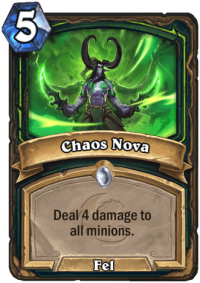
Fine, I’ll give it my best shot. What has prevented Hunter from playing a control deck? Lack of board clears and card draw. Demon Hunters have Chaos Nova and they have a lot of card draw. What about Rogue, another class that resembles Demon Hunter, why is there no Control Rogue? Because Rogue cannot heal – and the one time they could with Leeching Poison, it was so scary that the card was nerfed to the ground. Demon Hunters have several Lifesteal cards, although they tend to heal only a little at a time.
Demon Hunter does not have the toolkit to play a fatigue-style control deck. I’m sure many will rejoice at that news! Therefore, any slow Demon Hunter deck needs a proactive win condition.
For a control deck, big Demons could be the way to go. So far, we have Hulking Overfiend, Pit Commander, and Imprisoned Antaen as new Demon Hunter Demons. There are no big Neutral Demons so far.
Against a real control deck, big Demons do not seem very promising. They are not quick to get on the board, and any swing they can accomplish later in the game can be met with regular control tools. However, they can be strong against board-centric decks, because if the Demon Hunter survives long enough to get them rolling, their size makes them difficult to answer and Demon Hunter can then close out the game quickly.
Combo Demon Hunter
Some board clears, a fair amount of card draw, some healing. Those are the pieces combo decks are made of, so Demon Hunter combo decks do not seem far-fetched at all. Of course, there needs to be some actual combo at the end, and that is still missing in Standard.
For Wild, there is already at least one theorycrafted combo: First, you need an Emperor Thaurissan discount on Garrison Commander, Prince Taldaram, and Clockwork Automaton (two of the three is enough). Then, you need to play Metamorphosis and not use the Hero Power. On the turn after that, you play the minions so that you have two Clockwork Automatons on the board and can use your Hero Power twice: it deals 20 damage per hit for a total of 40 damage.
Demon Hunter combo decks resemble Rogue combo decks: the available control and healing tools are limited, and therefore speed is essential. Demon Hunter has a bit more in the way of board clears and healing than Rogue though, so the decks can become more consistent if a suitable combo finisher is found.
The Demon Hunter Playstyle
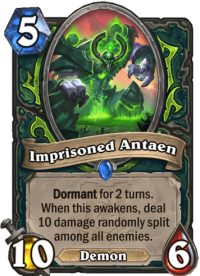
Given the tempo-oriented nature of Hearthstone, I expect Aggro Demon Hunters to be the most successful. They have the tools to rapidly develop a board while denying tempo from the opponent, and soon the game is over.
Big Demons also look interesting. I expect it to be somewhere between a midrange deck and a control deck: often having to defend early on to buy time for that Imprisoned Antaen and then getting a huge swing turn in the mid-game. Control decks should be able to contest it, but the current meta is not friendly to control decks, so if the swing turn succeeds, more aggressive decks might not have the tools to respond.
I don’t see how the token strategy can succeed, but there are still some new cards coming that may help. In the worst case, there’s always Murlocs.
Combo Demon Hunter is just waiting for the right finisher.
Overall, Demon Hunter looks like a strong class that fits well to the core design of Hearthstone as an active, tempo-based game. It is not a control class, but rather, as the developers described it, in your face all the time.

maybe there is potential in combo with soul split, copying a dormant demon
Very well written article and interesting read. In addition to all above mentioned deck archetypes, I believe there might be 2 extra ones that I don’t really see anyone talking about.
The first one is old school midrange miracle archetype. DH has plenty of card draw and more than enough cheap, tempo oriented cards to support this kind of strategy which might be further improved by upcoming Skull of Gul’dan from the new set. Full aggro DH has mainly minions with health below 2. It seems to me that Priest with Breath of the infinite, buffed Holy nova and sufficient healing will be near unwinnable matchup. Probably same goes for warrior. Hence I don’t really think that aggro DH will be top tier. However, more tempo oriented midrange miracle deck might be the correct approach.
The second archetype that could have some potential is a bit slower midrange deck, similar to Galakrond warlock. There are a lot of similarities on the horizon: they both draw fast, have some healing, some removal and are more than capable to fight for the board. As late game win condition, Zephrys and Alextrasza can be used. As you said, pure late game/fatigue DH is probably out of the question and big demon package might be better suited for this kind of deck.
We still need to see all but 1 legendaries for the class and they might make it more clear which direction DH will choose.